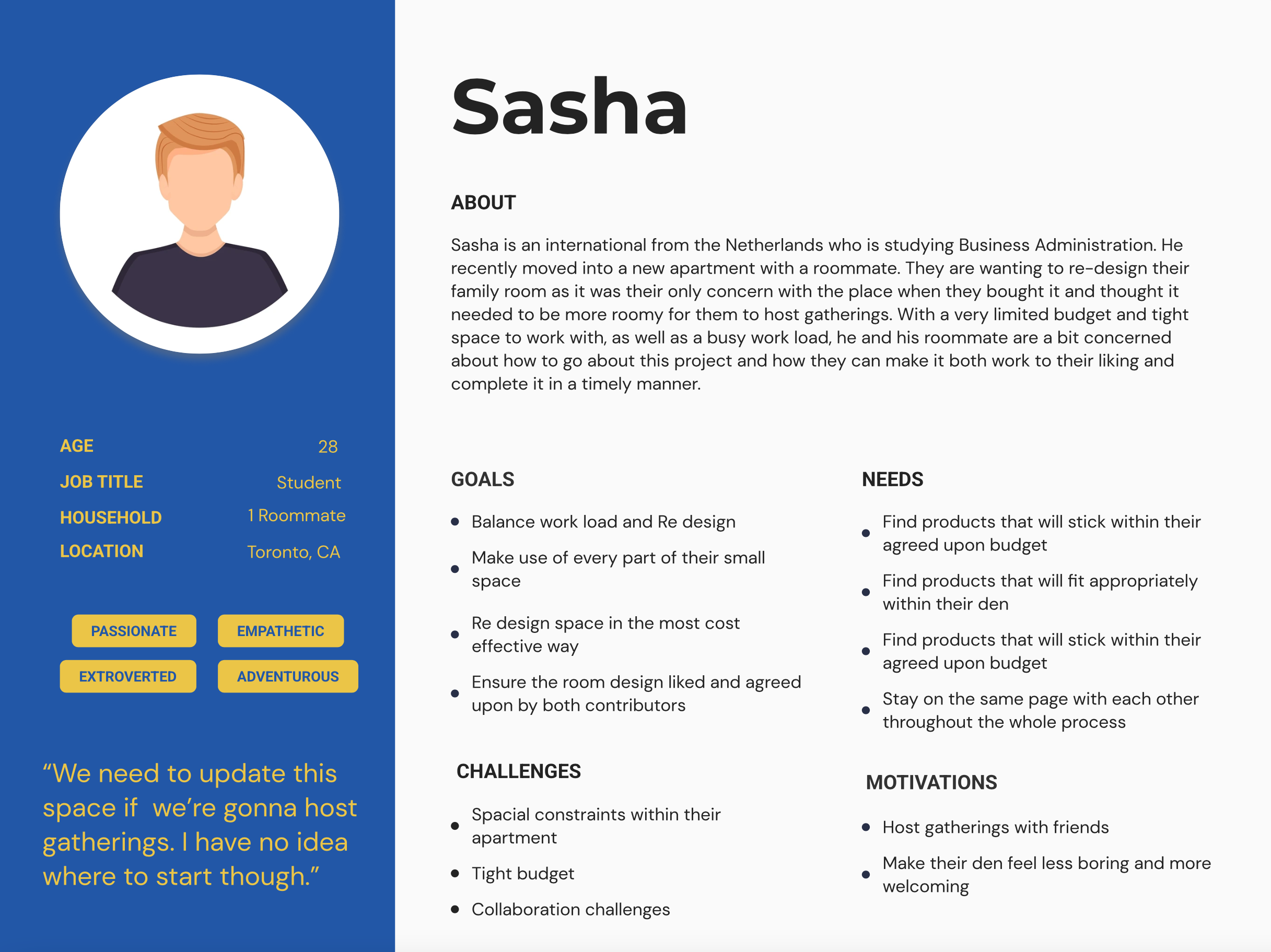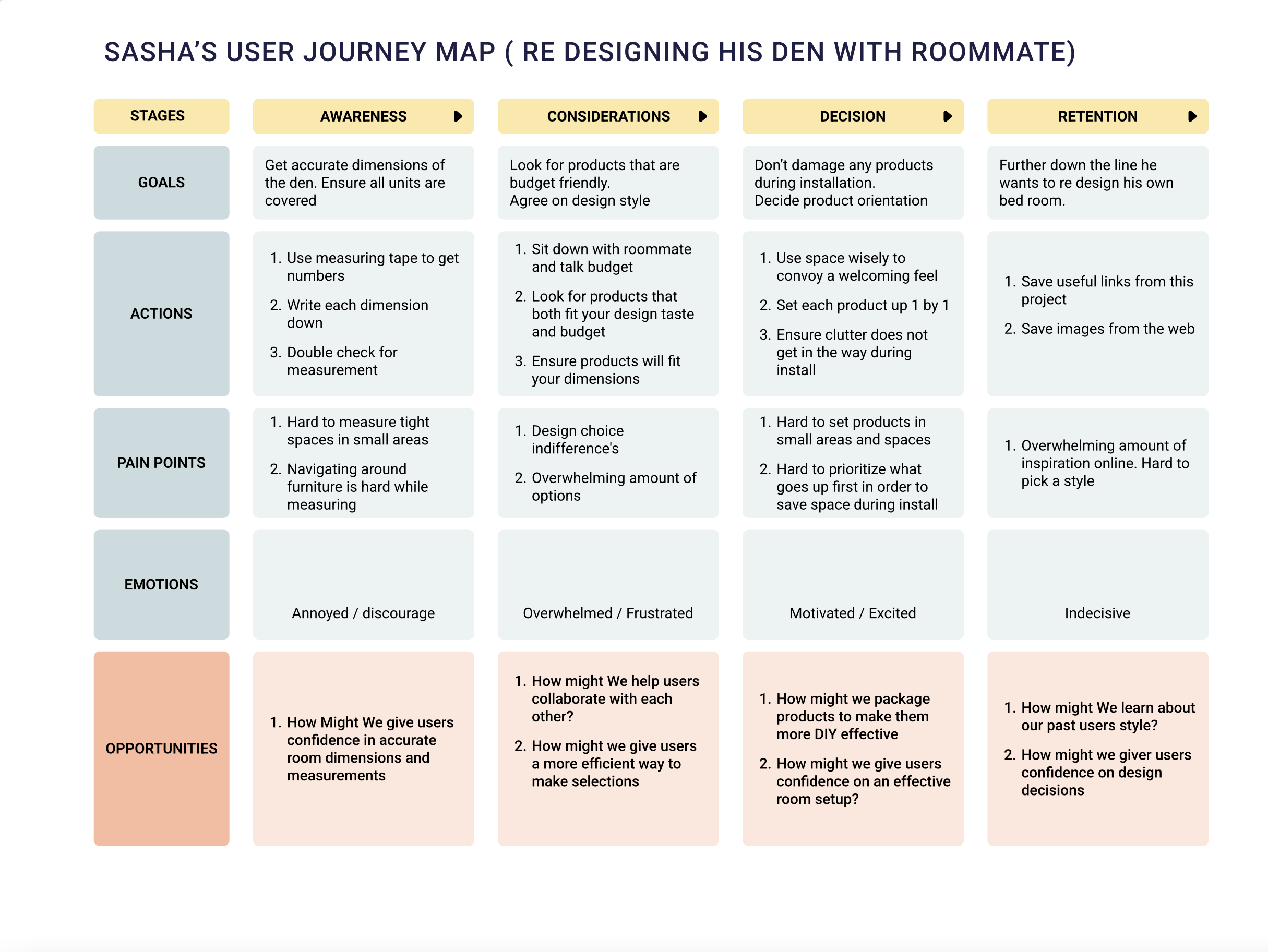This project leverages insights gained from a comprehensive competitive analysis involving major contenders such as Wayfair and Canadian Tire. By identifying areas of improvement within IKEA’s current website functionalities, the analysis revealed specific gaps that were predominantly within IKEA’S new VR feature, KREATIV. When synthesizing key insights extracted from both the competitive analysis and user interviews, my objective was to find key insights and opportunities for a reimagined IKEA KREATIV.
This was a research-based school project that focused on the first 2 phases of the UX design process. The objective was to understand out how to analyze and synthesis data to find detailed insights that relate back to the business goals and objectives.
Timeline ( 5 weeks)
- Heuristic evaluation & competitive analysis: 1 week
- Usability testing and user interview: 2 weeks
- Data analysis and synthesis: 1 week
- Recommendations and opportunities: 1 week
Research Methods Used
- Heuristic Evaluation
- User interviews
- Usability Testing
Heuristic evaluation and analysis findings
Flexibility and efficiency of use
- IKEA Kreativ tool’s effectiveness compromised during virtual room design on the website.
- Users redirected to a mobile app, causing an unexpected and potentially inconvenient transition.
- Disruption in the user experience observed, limiting the tool’s usability on the web platform.
Match between system and real world
- Preconfigured rooms (office, living room, bedroom, dining, etc.) differ in sizes and shapes from users’ actual home dimensions.
- Discrepancy compromises the tool’s efficiency, creating a mismatch between virtual and real-life proportions of users’ living spaces.
Visibility of system status
- Locating the IKEA Kreativ tool on the website presents a significant challenge.
- Users in need of room planning or renovation support face difficulties accessing the Kreativ feature.
- Hindrance observed in users’ ability to navigate and utilize this valuable resource.
Heuristic Evaluation Summary
Upon conducting a comprehensive heuristic evaluation of the KREATIV VR tool, it became apparent that three particular heuristics stood out as consistently and significantly violated. This discovery highlights key areas of concern that warrant focused attention and strategic improvements to elevate the overall user experience within the virtual reality environment.
Pre Testing and Interview phase
Hypothesis
Usability Testing
This usability testing plan is to identify common user pain points, challenges, and features users find helpful on the IKEA website and the IKEA Kreativ tool. The purpose of this usability test plan is to observe 5-10 participants while they use IKEA website and complete user tasks to improve the website.
Goals and Objectives
To identify pain points as well as to identify whether the participants agreed or disagreed with our own findings
Usability Metrics
The following criteria will be used to evaluate the product's usability: Success rate, error rate and time of completion
High level Usability Testing Result
Task: Find out if there is a tool on the website that can help you redecorate your room and check that your furniture will fit.
Usability Testing Summary
Having validated my hypothesis through the issues identified in the heuristic evaluation, the usability testing served as a robust confirmation that the encountered issues were indeed significant. Each identified issue appears to pose a considerable obstacle to IKEA’s business objectives, particularly in terms of revenue increase, customer retention, and client acquisition.
With the hurdles within the current product now established, my aim is to delve deeper into understanding what users value when redesigning a space in their homes. This deeper exploration not only aims to uncover opportunities for improvement but also supplements the recommended fixes within the current state of KREATIV. Through this comprehensive approach, I seek to address not only the identified issues but also align the redesign with user preferences, ensuring a more effective and user-centric solution.

User Interviews
Now that a usability test and heuristic evaluation was conducted and confirmed my research hypothesis correct, I wanted to dive deeper into what users value when redesigning a space of their own.
I conducted 4 user interviews with individuals who brought valuable expertise from their firsthand experiences in renovating and redesigning rooms. Prior to the interviews, I thoughtfully developed a screener to ensure the accuracy of the data and crafted a discussion guide to steer the conversations with well-framed, open-ended questions. These interviews provided invaluable insights and data, laying the foundation for synthesizing and creating a comprehensive user persona and journey map. This deepened understanding of our users has proven instrumental in shaping strategic design decisions
DATA ANALYSIS AND SYNTHESIS
User Persona
I’d like to introduce you to Sasha. A collective denominator who represents the 4 users I interviewed. Once the interviews were completed, I was able to synthesis and find common themes between the participants. Overall, Sasha represents and highlights the goals, needs and challenges that the participants expressed.
DATA ANALYSIS AND SYNTHESIS
JOURNEY MAP
Once the user personas were completed, I was able to create a detailed journey map that highlights Sasha’s journey in redesigning his den with his roommate. The biggest take away from this was finding opportunities where KREATIV tool could assists in all aspects of Sasha’s journey.
Opportunities & Recommendations
Current state recommendations for KREATIV
- Make virtual rooms more visible from different sides as well as a top view
- Measurable dimensions for virtual rooms
- View products in Ikea Kreativ directly from the product page
- Let IKEA Kreativ users use the tool without having to download the app.
Future state opportunities for KREATIV
- How Might We give users confidence in accurate room dimensions and measurements?
- How might We help users collaborate with each other?
- How might we give users a more efficient way to make selections?
- How might we package products to make them more DIY effective
- How might we give users confidence on an effective room setup?

